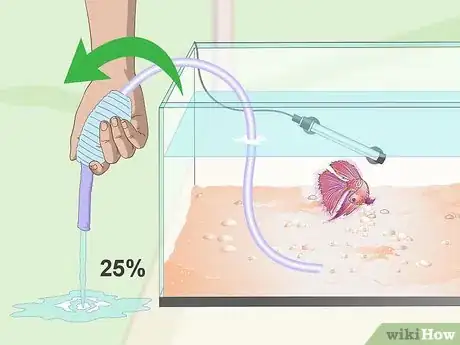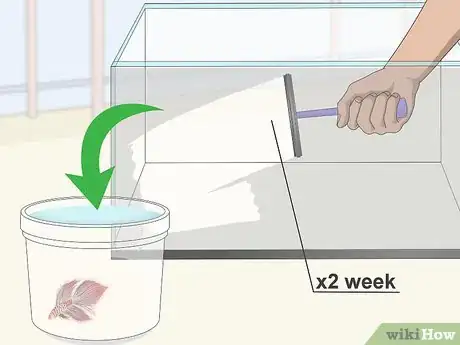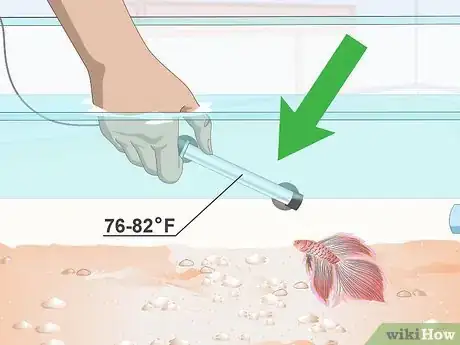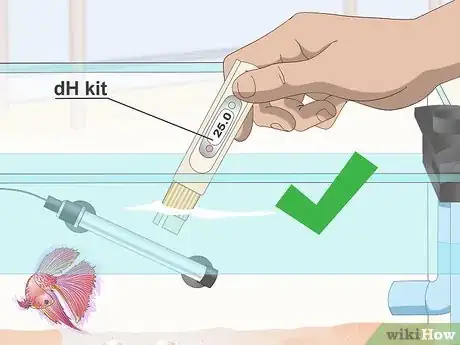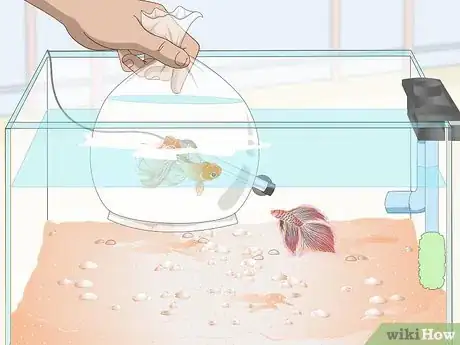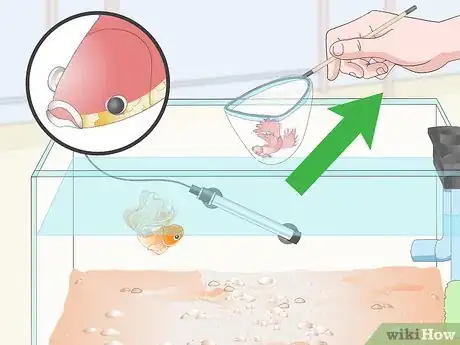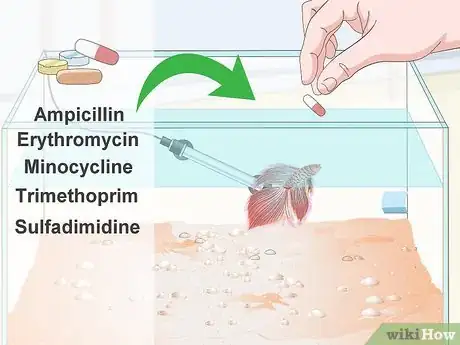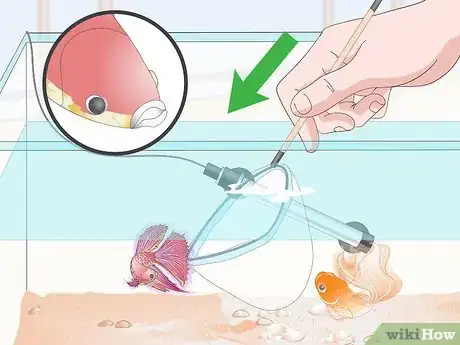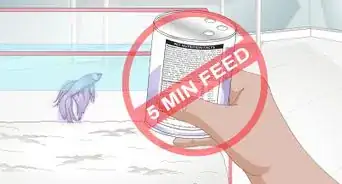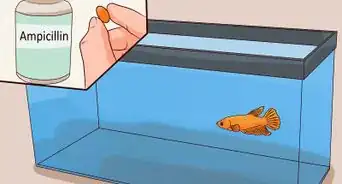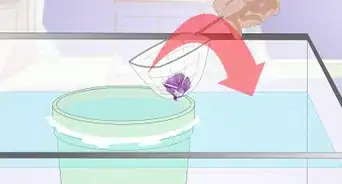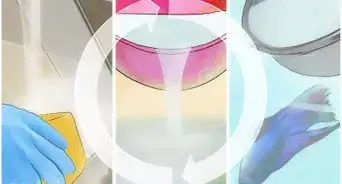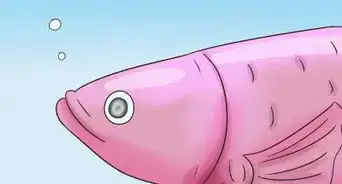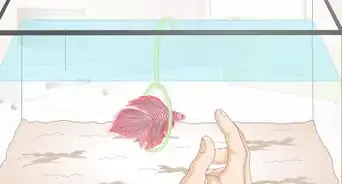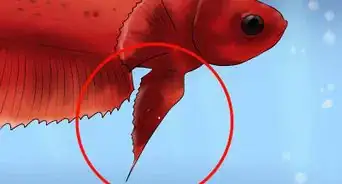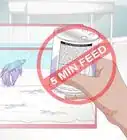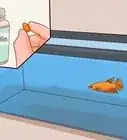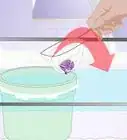This article was co-authored by wikiHow Staff. Our trained team of editors and researchers validate articles for accuracy and comprehensiveness. wikiHow's Content Management Team carefully monitors the work from our editorial staff to ensure that each article is backed by trusted research and meets our high quality standards.
wikiHow marks an article as reader-approved once it receives enough positive feedback. In this case, 91% of readers who voted found the article helpful, earning it our reader-approved status.
This article has been viewed 102,524 times.
Learn more...
It happens suddenly: last week you had a seemingly healthy betta fish, but now its eyes are buggy, foggy, and sticking out of its head. Unfortunately, your betta is experiencing a symptom known as popeye, in which fluid builds up behind the fish’s eye. Though never fun, a fresh environment, isolation, and medication will get your betta back to normal and prevent further outbreaks.
Steps
Preventing Popeye
-
1Change the water regularly. The most common cause of popeye is dirty water, and the best form of prevention is frequently replacing the dirty tank water with fresh water. Always have clean water in the betta’s fish tank or bowl to ensure that it won’t get popeye.
- If your betta is kept in a bowl or tank that holds two gallons of water or less, change a third of the water every 3-4 days.
- If your betta is kept in a larger aquarium, change 10% to 25% of the water every 2-4 weeks. [1]
-
2Gently remove your betta fish with a net and place it into a separate clean bowl of water.
- Dump out all of the water in the fish tank, remove all rocks and decorations, and rinse them with clean water.
- Using a paper towel, scrub the inside walls of the tank.
- Put the rocks and decorations back in the tank and fill the tank most of the way with bottled drinking water or pretreated tap water before putting your betta fish back in.
Advertisement -
3Keep the tank water warm. The natural habitat for betta fish is warm, stagnant water. Make sure the water is kept between 78 and 82 degrees Fahrenheit (24.4-27.7 degrees Celsius) in order to provide a healthy environment for your fish.[2]
-
4
-
5
-
6Carefully introduce new fish to the fish tank. Different fish require different environments, so make sure that you don’t add any fish to your tank that have conflicting environmental needs. Popeye often occurs when the tank water is not kept at the proper levels, and adding a new fish that thrives in a different kind of ecosystem might throw off those levels.
Treating Popeye
-
1Isolate the betta fish. You should remove any hazardous decorations or aggressive fish from your betta’s environment. Your fish’s vision is most likely impaired, which means that the likelihood of running into sharp objects inside the aquarium or getting even more injured by other fish is higher. Avoid this easily by putting your fish in its own separate tank temporarily.
-
2Put epsom salts in the fish tank. Epsom salt, or magnesium sulfate, does a good job of removing the fluid that’s built up behind your betta fish’s eye. Every three days, add one tablespoon for every 5 gallons (18.9 L) of water that your fish is in.[7]
-
3Add an antibiotic to the betta fish’s water. There are several different antibiotics that when added to the betta fish’s water, will make the popeye subside. Typically, you can purchase these antibiotics at pet stores.
- Put ampicillin in the fish tank and switch out the water every third day. Administer the medicine until a week after your fish’s popeye has gone away.[8]
- If you catch the popeye early enough, you can use erythromycin, minocycline, trimethoprim, or sulfadimidine, which are all antibiotics typically used to treat fin rot.
-
4Return your betta fish to its original tank after the swelling subsides. It can take anywhere from a couple weeks to a couple months for the swelling to go down, and even longer for cornea damage to improve. Reintroduce your betta to its original environment a couple of weeks after its eyes look their normal size.
- In more severe cases, one of the betta’s eyes might decay and fall off during the healing process. If this happens, keep your betta isolated permanently.
Community Q&A
-
QuestionIf I don't treat the popeye, will the betta die?
 Community AnswerYes. All diseases, if not treated, can cause death in fish. If popeye is not treated, your fish will eventually die an uncomfortable death.
Community AnswerYes. All diseases, if not treated, can cause death in fish. If popeye is not treated, your fish will eventually die an uncomfortable death. -
QuestionIs API aquarium salt the same as Epsom salt?
 Community AnswerNo, they are not the same. Aquarium salt is sodium chloride and Epsom salt is magnesium sulfate. They can both be used in aquariums, but they will have different effects, so you just need to do some research as to which will be most beneficial to you. The API website has some good information.
Community AnswerNo, they are not the same. Aquarium salt is sodium chloride and Epsom salt is magnesium sulfate. They can both be used in aquariums, but they will have different effects, so you just need to do some research as to which will be most beneficial to you. The API website has some good information. -
QuestionHow much epsom is required for a 1-gallon tank? I have a delta tail male betta with one bulging eye. Should I put in the salt when I put in chlorine remover?
 Grace BrownCommunity AnswerUse water from the other tank, and add one teaspoon, give or take. Add less if your fish is older, more critical or not as bad.
Grace BrownCommunity AnswerUse water from the other tank, and add one teaspoon, give or take. Add less if your fish is older, more critical or not as bad.
Warnings
- If not a result of unclean water, your fish’s popeye might be the result of a severe fatal disease, such as tuberculosis.⧼thumbs_response⧽
- Chlorine is deadly to betta fish, so use a filter to eliminate any traces of it in the tap water that you put into the fish tank.[9]⧼thumbs_response⧽
References
- ↑ https://www.petco.com/content/petco/PetcoStore/en_US/pet-services/resource-center/caresheets/betta.html
- ↑ http://www.bettafishcenter.com/water-quality-betta-health.shtml
- ↑ http://www.bettafishcenter.com/water-quality-betta-health.shtml
- ↑ http://www.ratemyfishtank.com/blog/properly-maintaining-the-ph-in-a-freshwater-aquarium
- ↑ http://www.bettafishcenter.com/water-quality-betta-health.shtml
- ↑ http://www.petsmart.com/learning-center/fish-care/healthy-aquarium-water/A0083.html
- ↑ https://www.fishlore.com/aquariummagazine/dec07/fish-popeye.htm
- ↑ https://www.earthsfriends.com/betta-fish-diseases/
- ↑ http://www.bettafishcenter.com/water-quality-betta-health.shtml
About This Article
To prevent popeye, change your betta’s water every 1 to 2 weeks. Make sure you replace 10 to 25% of the water in full aquariums and 50% of the water in small tanks. To keep the water clear, clean unfiltered tanks every week and filtered tanks every 2 weeks. Try to maintain a tank temperature between 76 and 82 °F. Remember to check your container’s pH level using a pH test strip: if it’s above 7, filter your tank water through peat moss, if it’s below 6.5, add baking soda or shells. For advice on treating a fish with popeye, scroll down!
